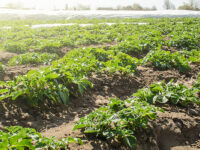 One of Australia’s best competitive advantages is its reputation as a producer of world-class produce, coupled with our diverse agricultural economy, closeness to key Asian markets and the tourism generated by our pristine and special environments.
One of Australia’s best competitive advantages is its reputation as a producer of world-class produce, coupled with our diverse agricultural economy, closeness to key Asian markets and the tourism generated by our pristine and special environments.
Agriculture is the future for Australia’s economy, and we need massive infrastructure projects to deliver water to make more land arable.
Biosecurity, or the lack of it, is an obvious threat. The impact of pests and disease can be devastating to agriculture, communities, regions, the economy, our reputation and our national livelihood.
An increasing proportion of Australia’s fast-moving consumer goods are imported so there is increasing emphasis on suppliers, their vendors, shipping companies, ports and the Australian government to protect our biosecurity. The government has developed activities in key overseas areas focussed on lessening risk through intelligence, surveillance, looking at shipping ballast tank issues and undertaking audits and verification processes.
At the borders, multi-modal programs enhance compliance, standards have been improved to address new threats, and inspections of passengers, luggage and cargo have increased.
Scale of threat
One large FMCG company receives more than 2000 40ft containers, mainly from Asia, every year, giving an idea of the scale of potential threats.
South American fire ants were found near the Port Botany container terminal in Sydney two years ago. The insect has a painful sting that impacts humans, pets and livestock. In South America, $7 billion a year is spent to control the pests, which cause about 80 deaths a year. Colonies of fire ants have been found tucked away inside shipping containers.
Initially contained in South America, the Zika virus is now the subject of a government warning to Australians travelling to Indonesia. A mosquito could easily survive the transit in a container from Indonesia to Australia.
What is the answer? Do we need to go back to the old days when planes were sprayed on arrival at Australian airports from certain overseas countries? Should all sea and air containers go through an Australian Quarantine and Inspection Service (AQIS) process on arrival?
Much to protect
Perhaps when containers are X-rayed for contraband they should also be gassed to kill any pests. But what about carry-on baggage on planes, cruise-ship luggage and ballast tanks, not to mention container ships and their ballast tanks? Pests can also survive on ship hulls. The ABS valued Australia’s primary production sector at $54 billion for the financial year ended June last year, so we have much to protect.
The only way to protect Australia is to inspect and spray every sea and air container from risky origins or which have travelled through risky countries. Sure this will add cost and potentially cause delays at ports, but the cost is insignificant when Australia’s livelihood and future is at risk. With the shortcuts taken by some sea and air carriers, they cannot be relied on to undertake this task.
Australia and New Zealand are special in that they can grow considerably diverse food items, and with jobs and wealth being created, our respective governments need to protect our borders vigorously.
Early in the 20th century it was said that Australia rode on the sheep’s back. My prediction, well into the 21st century, is that agriculture will be our dominant industry with a competitive advantage, and we need to take steps to ensure we expand our arable land resources, improve transport and tighten biosecurity.
Mark Skipper is chairman of the Supply Chain & Logistics Association of Australia (SCLAA). This article was first published in the July edition of Inside FMCG. Subscribe now.










